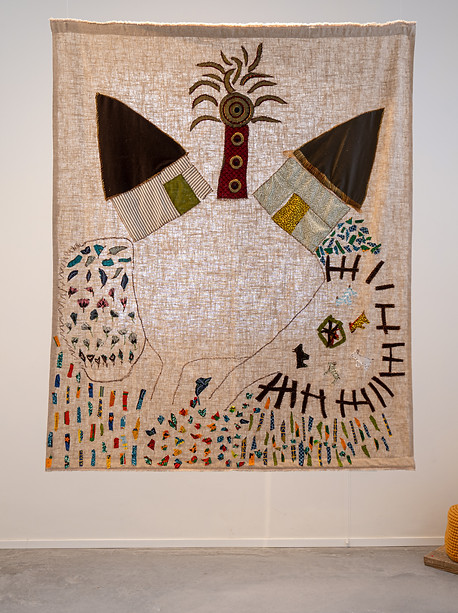The One World
Le Tout Monde
העולם
האחד
العالم
الواحد

11.06.2022
Erada Jumaa
איראדה ג׳ומעה
Lina Otom Jak Agolon
לינה אוטום ג׳ק אגולון
Mabrhit Ghebremariam
מברהט גברמרים
Ohad Meromi
אוהד מרומי
Curator Sandra Weil
אוצרות סנדרה וייל
Donkey Ohad Meromi
2022, 3D print & crochet, 25x20x10 cm





Lina Otom Jak Agolon
My home in Tuar (The One World)
2022
-
Mixed media on textile, 155x136 cm

Lina Otom Jak Agolon
My water jars
2022
-
Crochet baskets, 37x27 cm

Ohad Meromi
Untitled
2020
-
Diptych, collage & acrylic on panel 35x47 cm

Mabrhit Ghebremariam
Siwa

Erada Jomaa
Forbidden
2019
-
Acrylic on canvas, 90x90 cm
Exhibition views: Daniel Hanoch
The One World
Le Tout Monde
העולם האחד
In this exhibition, curator Sandra Weil, born in the Swedish archipelago and a resident of the one world, creates a unique connection between African-European, and Israeli-Palestinian cultures, focusing mostly on the relations between art and craft that sparked the beginning of early European, Israeli, and Arab modernism.
Erada Jumaa presents two charged works wrapped in soft materials and beautiful calligraphy. “Female” (أنثى) is a large embroidery on golden fabric. The letters are made of small cubes stacked like Lego pieces or like bricks to create what might look like a fortress or encampment. Her second work leaves an empty space on the canvass in the shape of the Arab word “Forbidden” (ممنوع) surrounded by the many prohibitions placed on women by traditional religious and social powers.
Lina and Mabrhit are both members of Kuchinate—an arts-based economic and psychosocial collective for African asylum-seeking women. Their work reflects the places and traditions they come from. In time, their memories and knowledge change and the shapes they take reflect contemporary life here and now. For this exhibition, Lina Otom Jak Agolon created a large embroidery representing her home in Tuar in the south of Sudan. The layout is both fantastic and naïve, a mental map of a real place that does not exist anymore. The second work uses similar techniques and materials to create a mask of her grandfather Jak, who served as the head of the village.
For this exhibition, Mabrhit Ghebremariam designed and created “Jugs, Pots and Jars”. This beautiful soft shapes from crochet baskets refer to traditional containers of the local beer—suwa—originating from Tigray. Traditionally, suwa remains locally popular during social events, after (manual) work, and as an incentive for farmers and laborers. In the artists hands memory is shaped out of the materials of the past, transforming the original sharpness of the drink and the glass bottle into amenable materials that still preserve the ceremonial and communal qualities.
Ohad Meromi presents four recent works that elegantly move from craft to art and back.
This is a very intimate, almost private selection of pieces dear to the artist’s heart—the kind of things you can carry on journeys, like a visual diary or a home away from home. They remind one of the sources of inspiration, of past loves and lingering fascinations. Delicately woven or constructed, they are like and unlike experiments by Kandinsky in the late 20’s or by Paul Klee, another colleague at the Bauhaus. But they are also particularly African or somehow Native, with a hint of the kind of art that flourished in the Kibbutzim, merging hand-made crafts and modernism.
This show brings different cultures and religions together to form what Eduardo Glissant calls “an archipelago conversation”. Spanning three continents and three religions, this is a conversation that is “worldly” without being global, it addresses specific localities and artistic traditions, but it does so from multiple perspective erasing the hegemonic borders between first, second, and third world. The notion of “the one world” was coined by Glissant, one of the most important writers and philosophers of our times. Born in Martinique in 1928 and died in Paris in 2011, Glissant sought an alternative to globalization, on the one hand, and nationalism on the other. The one world is everyone’s world—it is a framework for thinking togetherness without sameness, and exchange without dominance. The one world is an archipelago of islands, each distinct and interrelated. The affinities can be sensed, they are aesthetical or pattern-like, and they concern simple and basic matters: creating a home, living with others, and being human.
Erada Jumaa, born 1994 in Tayibe, where she lives and works.
Lina Otom Jak Agolon, born 1976 in Atar, Southern Sudan (now South Sudan), lives and works in Tel Aviv
Mabrhit Ghebremariam, born 1992 in Eritrea, lives and works in Tel Aviv
Ohad Meromi, born in 1967 in Kibbutz Mizra, lives and works in New York